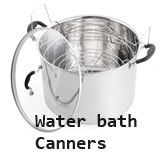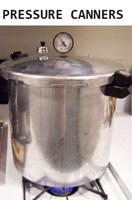
Currant U-Pick Orchards in Brant, Hamilton and Haldimand Area of Ontario in 2025, by county
Below are the U-Pick orchards and farms for currants that we know of in this area.
Not all areas of a province or region have currants orchards that are open to the public. If you know of any others, please tell us using the add a farm form!
Remember to always check with the farm's own website or Facebook page before you go - or call or email them if they don't have a website or Facebook page. Conditions at the farms and crops can change literally overnight, so if you want to avoid a wasted trip out there - check with the farm directly before you go! If I cannot reach them, I DON'T GO!
PLEASE report closed farms, broken links and incorrect info using the "Report Corrections" form below.
New! As inflation remains high, see this page for
reliable (tested) brands of generic canning lids at lower
costs, and cost-saving measures for
getting fruit and vegetables and home canning.
If you are having a hard time
finding canning lids, I've used these, and they're a great price & ship in 2 days.
New! Road tripping and camping is a great way to have a fun, safe and inexpensive family trip. The national and state parks and monuments are open, and campgrounds usually cost between $10 and $40 per night. September to November is the best camping weather. See our new website Road Tripping and Camping.com for tips, tricks, guides, checklists and info about parks, monuments and other places to visit.
New! We just went live with our latest website, FunFactoryTours.com - As they name implies, you can find a fun factory tour, including chocolate, automobiles, historical forts and sites, famous buildings, Active Federal facilities even fun geology: like fossils and volcanic areas
Brant (Brant, Brantford, Bruce, Burtch, Cathcart, Hatchley, Paris)
- Lindleys Farm and Market - Currants, strawberries, raspberries, pumpkins, peas.
900 Fiddler\'s Green Road, Ancaster, ON L9G 3L1. Phone: 905-648-4212. Directions: Located between Hamilton and Brantford, Ontario. Click here for a map and directions. lindleysfarmandmarket@gmail.com . Lindley's Farm & Market is conveniently . From Hamilton, exit Hwy 403 on Fiddler's Green Road. Turn south on Fiddler's Green Road and continue 2km to our farm on the right. From Brantford, exit Hwy 403 on Hwy 52, turn south and continue to Hwy 2, turn east and follow until Hwy 53. Proceed on Hwy 53 until Fiddler's Green Road, turn south, and follow for 2km to our farm on the right. Watch for the blue Ontario signs on Hwy 403A visitor writes on July 25, 2022: "We went picking twice this year. They were friendly when we picked strawberries during the week, but overcharged me for a full basket when my basket was missing a pint. The second time we went, it was the weekend. The lady who was managing the raspberry picking was yelling at everyone about parking, but the strawberry people had told us to park by her. The strawberry staff were rude to everyone that day. The raspberry lady was rude to everyone too. She overcharged me that day. Instead of $5 for half of a $10 basket, she charged me $7. They were all very temperamental with people, maybe because it was the weekend. In summary, they overcharged and weren't welcoming."
Hamilton (Alberton, Glanbrook, Hamilton, Hayesland, Kirkwall, Lynden,Sheffield, Renforth, Rockton)
- Lindleys Farm and Market - Currants, strawberries, raspberries, pumpkins, peas, Corn Maze, Fall school tours, Fall Festival
900 Fiddler\'s Green Road, Ancaster, ON L9G 3L1. Phone: 905-648-4212. Directions: Located between Hamilton and Brantford, Ontario. Click here for a map and directions. lindleysfarmandmarket@gmail.com. Lindley's Farm & Market is conveniently . From Hamilton, exit Hwy 403 on Fiddler's Green Road. Turn south on Fiddler's Green Road and continue 2km to our farm on the right. From Brantford, exit Hwy 403 on Hwy 52, turn south and continue to Hwy 2, turn east and follow until Hwy 53. Proceed on Hwy 53 until Fiddler's Green Road, turn south, and follow for 2km to our farm on the right. Watch for the blue Ontario signs on Hwy 403. Pick-Your -Own CropsJune: Strawberries, Green Peas, Beets. July: Red Raspberries, Black Raspberries, Red & Black Currants, Gooseberries. October: Pumpkin Hayrides every weekend in October! Over 50,000 pumpkins to chose from in our fieldsA visitor writes on July 13, 2013: (positive experience) "I have been going to Lindley's for many years now. I have been there at least 6 or 7 times this year. The berries are fabulous. Rita and Stella are always so friendly and helpful. All the staff, including their students are amazing. It is a wonderful experience and it is shame for anyone who has had a bad experience. My daughter did get yelled at another farm when she was 5. She is now done high school and she still remembers that lady yelling at her. We are all humans. We have our good days and perhaps some not so good. Go to Lindley's. It will be well worth your time and effort."
Comments from a visitor on September 07, 2011: (positive experience) "I have been picking berries at Linley's Farm for 5 or 6 years, and have always had a wonderful experience. I have never heard any shouting or rudeness; on the contrary the farm staff are good-humoured and very accomodating. I have seen many young children with parents and family groups who are enjoying the experience of "picking your own." I think parents need to be aware that this is a farm, someone's livelihood, and not an amusement park for kids. I always follow the directions of staff because I understand that these directions are part of good farm management - they know what they are doing. It's a give and take experinece - they get their fields picked in an organized manner, and I get tasty organic berries at a fair price. The taste and the fact that this farm doesn't use insecticides and fungicides is why I keep coming back. So don't listen to the complainers, this is a great farm."Has anyone else had experiences here, positive or negative, can either confirm or refute this one? If so, please write!
Currants
Currants Picking Tips, Recipes and Information
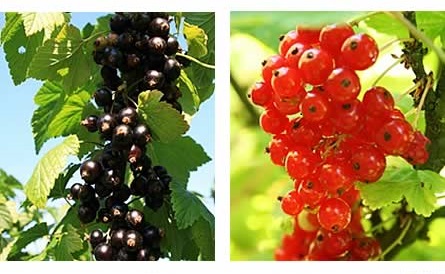
If you are about to pick currants either directly from a bush or from a local orchard or market, here's what you need to know to pick the best currants.
Currants are a fairly early crop, flowering soon after the last frosts in April and May, setting fruit in June, usually at the same time as strawberries in most areas (but check your area's harvest calendar and call the farm or orchard you are planning to go to a few weeks ahead).
Currants picking tips
When:
- Currants are typically ripe and ready for picking in the summer months, usually from late June to early August, depending on your location and the specific variety.
- Early morning is often the best time to pick currants. The berries are less likely to be stressed by the heat of the day, and they'll be at their juiciest.
- Try to avoid picking currants when they're wet from rain or dew. Moisture can cause the berries to deteriorate quickly and become moldy.
- Currant bushes can produce berries over a period of a few weeks. Check the bushes every couple of days to pick ripe berries and prevent overripening.
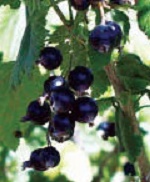
How:
- Make sure your hands are clean before you start picking to avoid transferring dirt or contaminants to the berries.
- Look for currant clusters that have plump, fully-colored berries. They should be slightly translucent and have a vibrant hue. Avoid berries that are underripe or overly soft.
- Hold the currant cluster gently but firmly, and use your other hand to pick the berries. Currants are delicate, so avoid pulling or tugging forcefully, as this can damage the branches.
- Proper Technique: Pinch the stem between your thumb and forefinger, then roll your fingers to detach the berries. This helps to prevent damaging the stem or the fruit.
- Leave some space between your fingers to prevent squishing the berries while you pick. Currants are small and can be easily damaged if you're not careful.
- Ripe currants should come off the stem with minimal effort. If you find yourself having to tug hard to detach a berry, it might not be fully ripe yet.
- While picking, keep an eye out for any signs of pests like aphids or caterpillars. Remove any infested berries to prevent spreading the issue.
- Use shallow containers, baskets, or colanders to collect the berries. This helps prevent crushing them under their own weight.
- Don't overfill your containers or try to pack the currants down.
- Respect the Plant. Be mindful not to damage the plant while you're picking. Avoid breaking branches or causing unnecessary stress to the bush.
After picking: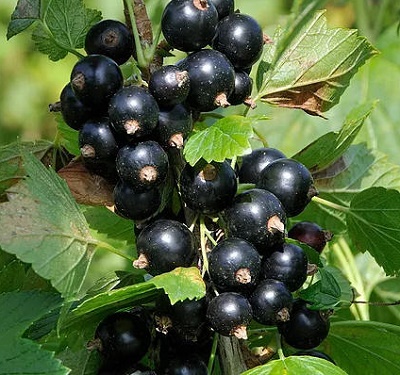
- After picking, gently transfer the currants into shallow containers or bags. Store them in the refrigerator as soon as possible to maintain freshness. Currants can also be frozen for longer storage.
- Avoid placing the picked currants in the sunshine any longer than necessary. It is better to put them in the shade of a tree or shed than in the car trunk or on the car seat.
- Cool them as soon as possible after picking. Currants may be kept fresh in the refrigerator for two or three days, depending upon the initial quality of the berry.
- Currants have a short shelf life compared to some other fruits, so plan to use or preserve them within a few days of picking. Remember that the specific techniques and tips may vary slightly based on the type of currants you are picking (red, black, or white currants), so it's a good idea to familiarize yourself with the characteristics of the particular variety you're working with.
Before you leave to go to the farm:
- Always call before you go to the farm - Currants are affected by weather (especially rain and cooler temperatures) more than most crops. And when they are in season, a large turnout can pick a field clean before noon, so CALL first! Always call before you go to the farm - Currants are affected by weather (especially rain and cooler temperatures) more than most crops. And when they are in season, a large turnout can pick a field clean before noon, so CALL first!
-
 Leave
early. On weekends, then fields may be picked clean by NOON!
Leave
early. On weekends, then fields may be picked clean by NOON! -
Most growers furnish picking containers designed for Currants, but they
may charge you for them; be sure to call before you go to see if you need to
bring
containers.
If you use your own containers, remember that heaping Currants more than 3 inches deep will smush the lower currants. Plastic dishpans, metal oven pans with 3 inch tall sides and large pots make good containers. I like the Glad storage containers like the one at right. - Bring something to drink and a few snacks; you'd be surprised how you can work up a thirst and appetite! And don't forget hats and sunscreen for the sun. Bugs usually aren't a problem, but some deet might be good to bring along if it has been rainy.
When you get home
- DON'T wash the currants until you are ready to use them. Washing makes them more prone to spoiling.
- Currants are more perishable than blueberries or strawberries, so make a point of refrigerating them as immediately as possible after purchase. Temperatures between 34 F and 38 F are best, but, be careful not to freeze currants! (Fresh currants are highly prone to freeze damage).
- Pour them out into shallow pans and remove any mushed, soft or rotting currants
- Even under ideal conditions currants will only keep for a few days in a refrigerator, so for best flavor and texture, consume or freeze them as soon as possible after purchase.
- See my How to freeze berries page. (Unless you're going to make jam right away)
- Now, get ready to make Currants jam - It is VERY easy - especially with our free Currants preserves instructions - illustrated and easy or cherry pie filling
Currants Recipes, Canning, Jam, Jelly, and related resources
- Currants jelly
- Currant jelly (unthickened)
- Currants festivals
- Currant facts - useful, interesting and fun facts
Currants varieties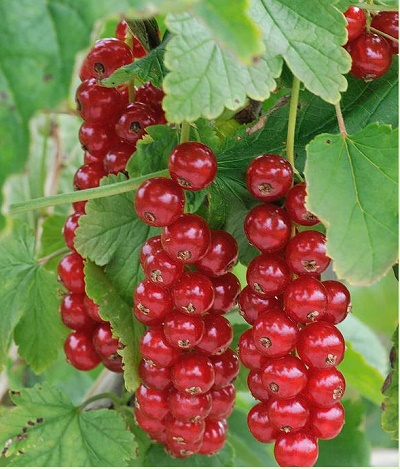
Here is a description of each type of currant
Red Currants:
- Small, round berries that are translucent and bright red when ripe.
- Tangy and slightly tart flavor, often used in jams, jellies, sauces, and desserts.
- Typically grow in clusters on deciduous shrubs.
- Rich in vitamin C and antioxidants.
- Commonly used in both sweet and savory dishes due to their tartness.
- Suitable for fresh consumption when fully ripe, but their intense flavor may be an acquired taste for some.
Black Currants:
-
Small, round berries that are dark purple to black when ripe.

- Distinctly strong, sweet-tart flavor with earthy undertones.
- Often used in jams, juices, syrups, desserts, and even alcoholic beverages.
- Grow in clusters on woody shrubs with distinctive five-lobed leaves.
- High in vitamin C, antioxidants, and other beneficial compounds.
- Considered to have potential health benefits due to their nutritional profile.
- The strong flavor can be polarizing, and some people might find it overpowering.
White Currants:
-
Similar in size and shape to red currants but are translucent to pale yellow or pink when ripe.
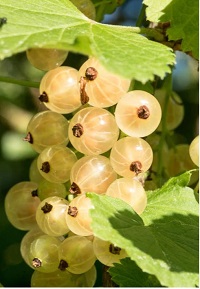
- Delicate and sweet with a mild, fruity flavor.
- Used in jams, jellies, preserves, and for fresh consumption, especially as a garnish.
- Grow in clusters on shrubs and are less common than red or black currants.
- Sometimes referred to as "albino currants" due to their light color.
- Lower in acidity compared to red and black currants, making them a milder option for those who prefer less tart flavors.
- Because of their light color, they can add an elegant touch to dishes and presentations.
Other Local Farm Products (Honey, Horses, Milk, Meat, Eggs, Etc.)
(NOT pick-your-own, unless they are also listed above)
- Farm markets and roadside stands
- Local Honey Finder
- Local Meat, Milk and Eggs
- Venues: Farms, Wineries, Orchards for your event, wedding or party
- Easter egg hunts
- Children"s consignment sales
- Fruit and vegetable festivals
- Winery tours and wine tastings
- Horse rides, stables, lessons, trails
- Maple Syrup farms and sugarworks
- Bed & Breakfasts on Farms, Wineries, Ranches and Orchards
- Pumpkin patches
- Corn mazes
- Zombie Paintball venues
- Christmas Tree Farms & lots
- Environmental resources
- Consumer fraud information
- Wholesale food sources
- Resources for Farmers
Looking for canning equipment and supplies?
Water bath canner with a jar rack
Pressure canners for gas, electric and induction stoves: Presto 23Qt or T-fal 22Qt
Canning scoop (this one is PERFECT)
Ball Blue book (most recent version)
Jars: 8oz canning jars for jams
Find Other types of farms:
Farm markets and roadside stands
Road trips and camping resources
Local Honey, apiaries, beekeepers
Consumer fraud and scams information
Home canning supplies at the best prices on the internet!
Maple Syrup Farms, sugarworks, maple syrup festivals
Environmental information and resources
Farms For Your Event for birthday parties, weddings, receptions, business meetings, retreats, etc.
Festivals - local fruit and vegetable festivals
Get the
most recent version of
the Ball Blue Book
With this Presto 23 quart pressure canner and pressure cooker, you can "can" everything, fruits, vegetables, jams, jellies, salsa, applesauce, pickles, even meats, soups, stews. Model 01781
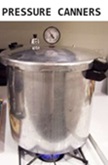
You can make jams, jellies, can fruit, applesauce, salsa and pickles with water bath canners, like this Granite Ware 12-Piece Canner Kit, Jar Rack, Blancher, Colander and 5 piece Canning Tool Set
